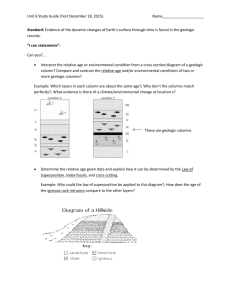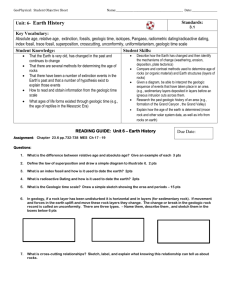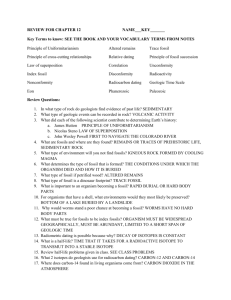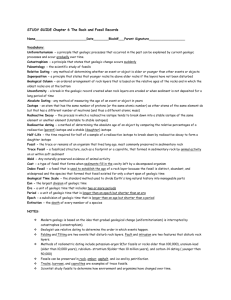Study Guide Key - West Branch Schools
advertisement
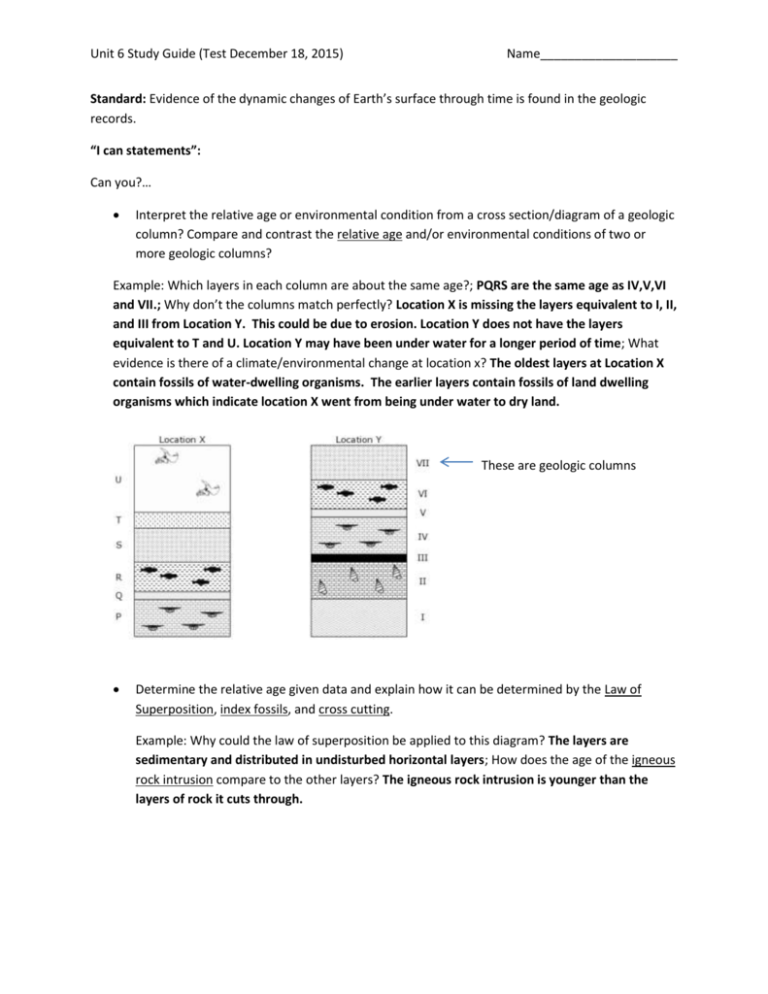
Unit 6 Study Guide (Test December 18, 2015) Name____________________ Standard: Evidence of the dynamic changes of Earth’s surface through time is found in the geologic records. “I can statements”: Can you?… Interpret the relative age or environmental condition from a cross section/diagram of a geologic column? Compare and contrast the relative age and/or environmental conditions of two or more geologic columns? Example: Which layers in each column are about the same age?; PQRS are the same age as IV,V,VI and VII.; Why don’t the columns match perfectly? Location X is missing the layers equivalent to I, II, and III from Location Y. This could be due to erosion. Location Y does not have the layers equivalent to T and U. Location Y may have been under water for a longer period of time; What evidence is there of a climate/environmental change at location x? The oldest layers at Location X contain fossils of water-dwelling organisms. The earlier layers contain fossils of land dwelling organisms which indicate location X went from being under water to dry land. These are geologic columns Determine the relative age given data and explain how it can be determined by the Law of Superposition, index fossils, and cross cutting. Example: Why could the law of superposition be applied to this diagram? The layers are sedimentary and distributed in undisturbed horizontal layers; How does the age of the igneous rock intrusion compare to the other layers? The igneous rock intrusion is younger than the layers of rock it cuts through. Unit 6 Study Guide (Test December 18, 2015) Name____________________ Example: Which fossil is the best index fossil in this example? Why? Fossil A makes a good index fossil because it can be found in only one layer (time period), but can be found at multiple locations. Explain how ice cores serve provide evidence of climate change throughout Earth’s history. Example: What kind of evidence do scientists gather from ice cores to learn about ancient climates? Scientists can gather clues about past atmospheric conditions from particles, dust or ash that is trapped in the ice. Bubbles give evidence about levels of past atmospheric gases that were present in the atmosphere. Measurements of the size of each layer can indicate the amount of precipitation that fell during certain time periods. Unit 6 Study Guide (Test December 18, 2015) Name____________________ Scientists call the snow that is above the ice at the polar areas, firn. Porosity is also another term scientists use to describe the amount of open/void spaces in a material. More porous materials have more air pockets or open spaces. So, firn is the porous snow (see the diagram). As we move deeper into the ice sheet, the firn becomes less porous and eventual turns into the ice at a zone called the “lock-in” zone. At this lock-in zone, the air bubbles are locked into the ice. Before, because the firn is porous, the air can move freely around. Therefore, in the upper most part of the ice sheet, the air in the firn is still exchanging with the atmosphere. Once locked into the ice, the air bubbles no longer exchange with the atmosphere. That is how ice core scientists can determine the concentration of gases in the ancient atmosphere. From: http://mindynicewonger.weebly.com/blog/how-ice-cores-are-dated Compare relative and absolute age. (You will not have to determine half-lives or explain the process of absolute dating). Example: What information can each method of dating provide a scientist? Relative dating can tell scientists if one fossil or rock is older or younger than something else (such as another fossil, rock, or rock layer.) Absolute dating can give scientists a numerical age/ date as to when a rock was formed or an organism was alive. Why is each method beneficial? Each method help scientists date evidence from the past and help piece together Earth’s geologic history. When can absolute dating be used and when can it NOT be used? Absolute dating (in the form of radioactive dating) can be used on fossils and igneous rocks. It is not likely to be used on sedimentary or metamorphic rocks. Explain how the geologic time scale is divided. Example: What evidence have geologists gathered from Earth that shows there have been changes in Earth’s history, climate and lifeforms? Geologists use evidence (relative and radioactive dating) from the fossil record to learn about changes in organisms and past environmental conditions; How do scientists use this evidence to create divisions in the geologic time scale? Scientists look for major changes in life forms at different times to mark when one unit of geologic time ends and the next begins. -Fossil seashells have been found in rock beds on land. What can you infer about how the area has changed? The area was probably under water at one time and had since dried out. Eras (pg. 124 in textbook) (WILL BE USED AS BONUS QUESTIONS ONLY!!!) “zoic” means ____life__________________ Cenozoic- “ceno” means ________recent___________ Common organisms: mammals Major event that began this era/ended the last era: Mass extinction including the extinction of the dinosaurs in the Mesozoic era Mesozoic- “meso” means ______middle____________ Common organisms: dinosaurs Major event that began this era/ended the last era: Mass extinction at the end of the Paleozoic era Paleozoic- “paleo” means ______old____________ Common organisms: “Cambrian explosion” of life; invertebrates to vertebrates Major event(s) that began this era/ended the last era: End of Precambrian time; Unit 6 Study Guide (Test December 18, 2015) Terms to know! Law of Superposition Sedimentary rock Fossil Index fossil Cross cutting Igneous rock intrusion Absolute dating Relative dating Radioactive/radiometric dating Paleontologist Ice core Half life Atom Element Radioactive decay Unconformity Name____________________
